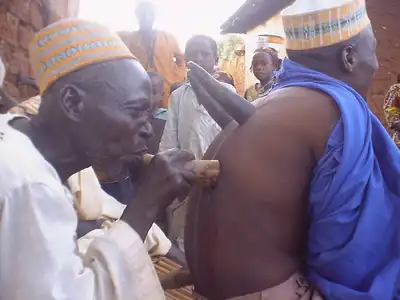Who is the Best Traditional Healer in South Africa?

Who is referred to as a Traditional Healer in South Africa?
Traditional healers of south Africa are practitioners of African medicine, they carry out different roles, including social and political roles like divination, emotional, spiritual, and physical healing, and a lot more.
Main types of Healers in South Africa?
There are two major types of traditional healers within the Nguni, Sotho Tswana, and Tonga societies of Southern Africa, the diviner (Sangoma) and the herbalist (Inyanga).
Who is the best Traditional healer in south Africa?
The Zulu is known in history to have quite effective traditional healers in South Africa, as the word sangoma was actually from Zulu. In Zulu tradition, God is believed not to be involved in human affairs and is not a common cause of illness(isifo). However, God delegated many administrative tasks to the ancestors, who were very involved in the living world.
The sangoma reads the dingaka to detect the presence of a spirit around a sick person, a resentful ancestral spirit.
Offended nature spirits, or evil spirits.
Highly skilled sangoma is said to be able to make herbal medicines interpret dreams, incorporate spirits, control weather, and predict the future.
What Are Indigenous Healers Called in South Africa?
In South Africa, isangomas and inyangas are the two significant kinds of indigenous healers. Isangomas are shamanic healers, and they frequently serve as diagnosticians. They often see people as a family, but sometimes individuals seek them out. Inyangas, on the other hand, are usually associated with curing illnesses.
South Africa has two indigenous healers: the isangomas and the inyangas. Isangomas are spirit healers, and they often function as diagnosticians. The people who visit the sangama often visit in family groups, but sometimes they go alone.
Who Is a Sangoma in South Africa?
Spiritual guides, healers, priests, and prophets are shamans.
For eons, the Bantu people of southern Africa relied on sangomas or inyangas to heal, prize, and prophesy.
For eons, the Bantu rural communities of Southern Africa have relied on sangomas or inyangas shamans, healers, priests, and prophets to provide spiritual and medical assistance.
What Are Witch Doctors Called in South Africa?
The term “witch doctor” was first used in 1836 to describe southern Africa’s shamanic healers (i.e., sangomas). A sangoma is a traditional healer in southern Africa.
How Do You Know If You Are a Sangoma?
A sangoma’s long woolen wig with beads, which symbolizes her humility before God, is accompanied by a headband signifying her purity of thoughts. A leopard skin skirt and red blouse, which express her honesty and courage, are worn in addition to a white blouse indicating her willingness to sacrifice herself for her people.
The long woolen wig with beads symbolizes humility before Sangoma women wear God to express the purity of thoughts. A headband indicates honesty and courage, and a leopard skin skirt symbolizes honesty. Occasionally, a red blouse indicates that the sangoma is ready to sacrifice herself for her people.
Why Do Sangomas Wear Beads?
Individuals who practice sangomas or n’angas frequently wear amulets and beaded work to identify themselves and their profession or seek assistance. They provide beaded items for individuals who want support with specific spiritual concerns or areas of their life.
Amulets and beading are used by many n’angas or traditional healers to identify themselves and their profession or to assist them in their work. Those who feel they require assistance in specific spiritual issues or areas of their life may receive beadwork.
Why Do Sangomas Wear Red?
Blood is the symbol of the blood of life.
During the second phase of ukuthwasa, a sangoma’s training begins. White clothing, a symbol of bones belonging to ancestors, is replaced by red clothing, a symbol of blood, which represents life.
Once a person has finished the first stage of ukuthwasa, training to become a sangoma, they begin the second stage, wearing red clothing instead of white, which symbolizes blood rather than ancestors’ bones.
Share This





